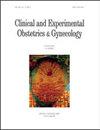女性慢性乙型肝炎病毒DNA对卵巢储备功能及体外受精结果的影响分析
IF 0.6
4区 医学
Q4 OBSTETRICS & GYNECOLOGY
引用次数: 1
摘要
背景:评价乙型肝炎病毒(HBV)-DNA拷贝对感染HBV妇女卵巢储备功能和体外受精(IVF)结果的影响。方法:对9927对首次IVF周期的夫妇进行回顾性研究。经筛选,1570对夫妇(546名hbv血清阳性妇女和1024名hbv血清阴性妇女,其伴侣为hbv血清阴性)未符合纳入标准。根据血清中HBV-DNA滴度,将hbv -血清阳性组分为dna高拷贝组(n = 139)、dna低拷贝组(n = 241)和dna阴性组(n = 166)。所有患者均采用长期下调治疗方案控制卵巢过度刺激,然后进行体外受精。结果:与hbv阴性组相比,高拷贝hbv阳性妇女的窦卵泡计数(AFC)(11.9±4.3比13.3±3.2)较低,取卵数(9.2±5.7比13.1±6.1)较低,AFC<8的比例(7.9%比3.1%)较大,抗苗勒管激素(AMH) <2 μg/L的比例(8.6%比4.3%)较大。高拷贝组和低拷贝组受精率较低(70.9%和72.5%比75.1%),高级别胚胎率较低(51.5%和53.8%比56.9%),着床率较低(31.3%和32.7%比38.5%),临床妊娠率较低(40.3%和42.3%比49.6%)。45.5%和48.8% (ET组为56.8%)比hbv阴性组高。两组早期流产率分别为19.6%和15.7%,高于7.1%。结论:HBV-DNA可能对女性卵巢储备功能产生负面影响,从而导致IVF治疗中受精率低、临床妊娠率低、早期流产率高。本文章由计算机程序翻译,如有差异,请以英文原文为准。
Analyzing the detrimental effects of female chronic hepatitis B virus DNA on ovarian reserve function and results of in vitro fertilization
Background: To evaluate both the impact of hepatitis B virus (HBV)-DNA copies in women with HBV infection on the ovarian reserve function and outcomes of in vitro fertilization (IVF).Methods: We conducted a retrospective study on a total of 9927 couples undergoing their first IVF cycle. After filtering, 1570 couples (546 HBV-seropositive women and 1024 HBV-seronegative women whose partners were HBV-seronegative) failed to meet inclusion criteria. According to the HBV-DNA titers in serum, the HBV-seropositive group was divided into three groups: DNA-high copy group (n = 139), DNA-low copy group (n = 241), and DNA-negative group (n = 166). All patients underwent controlled ovarian hyperstimulation using the long downregulation protocol followed by IVF. Results: Compared with the HBV-negative group, HBV-positive women with high DNA copy exhibited lower antral follicle count (AFC) (11.9 ± 4.3 vs 13.3± 3.2), lower number of oocyte retrieved (9.2± 5.7 vs 13.1± 6.1), larger proportion of AFC<8 (7.9% vs 3.1%) and anti-mullerian hormone (AMH) <2 μg/L (8.6% vs 4.3%). Both high-DNA copy and low-DNA copy groups exhibited a lower fertilization rate (70.9% and 72.5% vs 75.1%), lower high-grade embryo rate (51.5% and 53.8% vs 56.9%), lower implantation rate (31.3% and 32.7% vs 38.5%), lower clinical pregnancy rate (40.3% and 42.3% vs 49.6% per cycle with OR; 45.5% and 48.8% vs 56.8% per cycle with ET) than the HBV-negative group. Moreover, a higher early abortion rate (19.6% and 15.7% vs 7.1%) was observed in the above two groups. Conclusion: HBV-DNA may have a negative effect on women’s ovarian reserve function which in turn results in poor fertilization rate, clinical pregnancy rate and high early abortion rate in IVF treatment.
求助全文
通过发布文献求助,成功后即可免费获取论文全文。
去求助
来源期刊
CiteScore
0.50
自引率
0.00%
发文量
241
审稿时长
1 months
期刊介绍:
CEOG is an international, peer-reviewed, open access journal. CEOG covers all aspects of Obstetrics and Gynecology, including obstetrics, prenatal diagnosis, maternal-fetal medicine, perinatology, general gynecology, gynecologic oncology, uro-gynecology, reproductive medicine, infertility, reproductive endocrinology, sexual medicine. All submissions of cutting-edge advances of medical research in the area of women''s health worldwide are encouraged.

 求助内容:
求助内容: 应助结果提醒方式:
应助结果提醒方式:


